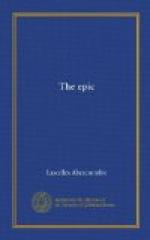It has already been remarked that the ultimate significance of great drama is the same as that of epic. Since the vital epic purpose—the kind of epic purpose which answers to the spirit of the time—is evidently looking for some new form to inhabit, it is not surprising, then, that it should have occasionally tried on dramatic form. And, unquestionably, for great poetic symbolism of the depths of modern consciousness, for such symbolism as Milton’s, we must go to two such invasions of epic purpose into dramatic manner—to Goethe’s Faust and Hardy’s The Dynasts. But dramatic significance and epic significance have been admitted to be broadly the same; to take but one instance, Aeschylus’s Prometheus is closely related to Milton’s Satan (though I think Prometheus really represents a monism of consciousness—that which is destined—as Satan represents a dualism—at once the destined and the destiny). How then can we speak of epic purpose invading drama? Surely in this way. Drama seeks to present its significance with narrowed intensity, but epic in a large dilatation: the one contracts, the other expatiates. When, therefore, we find drama setting out its significance in such a way as to become epically dilated, we may say that dramatic has grown into epic purpose. Or, even more positively, we may say that epic has taken over drama and adapted it to its peculiar needs. In any case, with one exception to be mentioned presently, it is only in Faust and The Dynasts that we find any great development of Miltonic significance. These are the poems




